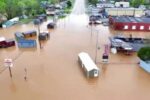More rounds of thunderstorms are expected to hit regions of the Midwest and South, and forecasters are warning of powerful tornadoes and potentially fatal flash flooding.
The Weather Prediction Center, a division of the National Weather Service, warned that beginning Wednesday, the powerful storm system would pose a risk of “significant, life-threatening flash flooding.”
Residents in some areas of Michigan are still recovering from a weekend ice storm, which coincides with the current flood threat.
Towns might be flooded, and cars could be washed away.
Beginning midweek and continuing through Saturday, thunderstorms with several rounds of intense rain are predicted for portions of Texas, the Ohio Valley, and the lower Mississippi Valley.
Forecasters caution that the storms may frequently pass over the same regions, bringing with them deadly flash floods that could sweep cars away along with torrential rains.
According to the weather service, there is a very high chance of flooding this week in parts of Arkansas, west Tennessee, western Kentucky, and southern Indiana.
The meteorological agency cautioned that during the next seven days, rain up to 15 inches (38 cm) is expected in northeastern Arkansas, the southeast corner of Missouri, western Kentucky, and southern Illinois and Indiana.
Rainfall might only occur once every 25 years
Thomas Jones, a meteorologist with the National Weather Service in Little Rock, Arkansas, stated that we might be in for almost two months of rain in a few days.
March’s monthly average rainfall in Little Rock is slightly less than 5 inches (12.7 cm). It is only anticipated that eastern and northern Arkansas will get rainfall once every 25 to 50 years.
According to Jones, the forecast’s heavy rainfall is unusual, and the Gulf’s moisture is increasing the quantity of precipitation that the thunderstorms may produce.

On Tuesday, the Midwest could be hit by powerful tornadoes
Forecasters warned that tornadoes could spin up in Kansas, Missouri, and Oklahoma on Tuesday.
Intense thunderstorms, including a few supercells, might form Tuesday night and overnight from central and southern Oklahoma up into central Kansas and western Missouri, according to the Storm Prediction Center of the National Weather Service in Norman, Oklahoma.
Extremely large hail, with a diameter of at least 2 inches (5 centimeters), a few tornadoes, some of which may be powerful, and high wind gusts are the main hazards. The cities of Wichita and Topeka in Kansas, as well as Oklahoma City, are the areas most vulnerable to a powerful tornado.
From Kansas City to Fort Worth, Texas, there is a chance of experiencing heavy hail.
On Wednesday, 43 million people are at risk of severe weather.
High winds and tornadoes are possible across a wide area of the country on Wednesday, extending from northeast Texas to Michigan. 43 million people and several of the biggest cities in the country, including as Chicago, Indianapolis, St. Louis, and Memphis, Tennessee, are in the region most at risk for severe weather.
Severe storms are also predicted for Nashville, Tennessee, Detroit, Dallas, and Milwaukee on Wednesday.
The earthquake center is ready for floods
The New Madrid Seismic Zone, which is the most active earthquake region in the country east of the Rocky Mountains, is where scientists continuously track seismic activity and is predicted to see the greatest rainfall.
The seismic zone, which is centered in southeast Missouri, stretches into Arkansas and Tennessee, among other neighboring states.
It is well-known for a string of strong earthquakes that struck most of the Midwest and South in 1811 and 1812. Another major earthquake in the area is possible, according to experts.
According to Mitch Withers, a research professor at the University of Memphis’ Center for Earthquake Research and Information, scientists have learnt from the flooding of the Mississippi River to be cautious about where they place monitoring equipment.
He stated that “we’ll still be getting our data and monitoring for earthquakes,” and that about 70 stations in the region should be safe from water.
This information has been sourced from AP News.







Leave a Comment